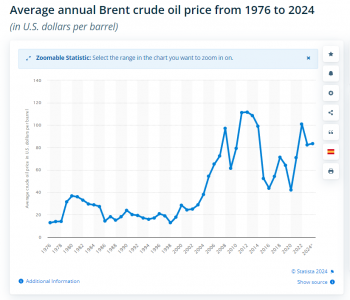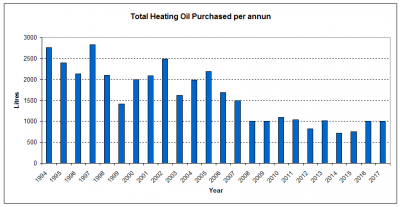Yes, I’m following the other thread too.
The 2900 rule of thumb is from Protons for Breakfast (and we tend to set the thermostat higher than 20C). From other posts I’ve read here it may be that with the ‘more comfortable, stable heating’ provided by an ASHP we MAY discover that we don’t need such a high temperature.
it was only a year ago that I began investigating our heating performance and prior to that we used overnight set backs and high flow and return (non-condensing) temperatures. Before retiring the thermostat would be set back while at work during the day, too.
I completely agree regarding label ratings; that’s what I meant (but didn’t articulate adequately).
When all is said and done, I think there are more than enough known unknowns and too many variables for me to determine the required peak power capacity with great accuracy, but I lean towards the existing performance as measured to support a discussion on, and validation of an ASHP design.
Posted by: @ianmk13The 2900 rule of thumb is from Protons for Breakfast (and we tend to set the thermostat higher than 20C). From other posts I’ve read here it may be that with the ‘more comfortable, stable heating’ provided by an ASHP we MAY discover that we don’t need such a high temperature.
Fair enough. They must have factored in an allowance for gas boiler efficiency.
Posted by: @ianmk13When all is said and done, I think there are more than enough known unknowns and too many variables for me to determine the required peak power capacity with great accuracy, but I lean towards the existing performance as measured to support a discussion on, and validation of an ASHP design.
Definitely, which is why I favour using multiple methods. I also plotted 3, 6, 12 and 24hr average power vs date, looked for peaks, downgraded my boiler to 8,5kW, still warm, and adjusted the ach in the spreadsheet to match the measured loss, which requires ach=0.5-0.75, plausible even though the original build is 1930s given subsequent upgrades, known 'marginal' ventilation, and recent comments from an individual in the industry that has measured ach on several properties and has 'never measured a value greater than 1'.
Still I have sone doubts of course, but at some point design choices have to be made. If they are wrong they won't be far out and can doubtless be mitigated on the few days in any year which are actually cold....until the gulf stream stops that is, estimated to be sometime between 2025 and 2100, with a most likely date of 2050.
4kW peak of solar PV since 2011; EV and a 1930s house which has been partially renovated to improve its efficiency. 7kW Vaillant heat pump.
Posted by: @ianmk13The 2900 rule of thumb is from Protons for Breakfast (and we tend to set the thermostat higher than 20C). From other posts I’ve read here it may be that with the ‘more comfortable, stable heating’ provided by an ASHP we MAY discover that we don’t need such a high temperature.
Fair enough. They must have factored in an allowance for gas boiler efficiency.
Posted by: @ianmk13When all is said and done, I think there are more than enough known unknowns and too many variables for me to determine the required peak power capacity with great accuracy, but I lean towards the existing performance as measured to support a discussion on, and validation of an ASHP design.
Definitely, which is why I favour using multiple methods. I also plotted 3, 6, 12 and 24hr average power vs date, looked for peaks, downgraded my boiler to 8,5kW, (Im still warm), and adjusted the ach in 'the spreadsheet' to match the measured loss, which requires ach=0.5-0.75, plausible even though the original build is 1930s given subsequent upgrades, known 'marginal' ventilation, and recent comments from an individual in the industry that has measured ach on several properties and has 'never measured a value greater than 1'.
Still I have sone doubts of course, but at some point design choices have to be made which, notwithstanding the claims made elsewhere, do affect many things, at least in my case, other than the odu. If they are wrong they won't be far out and can doubtless be mitigated on the few days in any year which are actually cold....until the gulf stream stops that is, estimated to be sometime between 2025 and 2100, with a most likely date of 2050. By 5hen this stuff is likely to be the least of my worries, if I am still alive which is doubtful.
4kW peak of solar PV since 2011; EV and a 1930s house which has been partially renovated to improve its efficiency. 7kW Vaillant heat pump.
@jamespa - an update on historical oil use. I was going through some old papers recently and came across delivery slips and invoices for oil deliveries that go much further back than the ones I previously had access to. It does seem that for whatever reason, I reduced my CH oil consumption in the late noughties from an annual average of around 2000L to 1000L. I have no idea how or why I did this, nor do I have any recollection of feeling colder in the house from the late noughties onwards, until after I stopped using oil and went over to standard mains electricity. All of which is to say that if the total period of oil use is taken into consideration, then the ASHP energy delivered starts to look even less exceptional than I previously thought.
Midea 14kW (for now...) ASHP heating both building and DHW
Thanks for the update which, together with your other recent posts, seems to point the finger at your oil setup being the mysterious part of the story.
I'm frankly amazed you halved your oil consumption without noticing the effects on comfort. Was something else changing at the same time?
4kW peak of solar PV since 2011; EV and a 1930s house which has been partially renovated to improve its efficiency. 7kW Vaillant heat pump.
Posted by: @jamespaI'm frankly amazed you halved your oil consumption without noticing the effects on comfort. Was something else changing at the same time?
Me too. The only explanation I can come up with is that I fine tuned the timing so that I only heated the house when necessary, morning and evening. Perhaps in the 1990s and early noughties, when oil was relatively cheap, I just had the heating on most of the time. In the early days I just filled the tank when necessary, but I do remember taking an active decision to only fill the tank in the summer, when oil tended to be cheaper, and that started happening in the mid noughties, suggesting I was conscious of costs. I think it is plausible I also looked at the timer settings at the same time, and tweaked the timing to limit the time the heating was on. Being a fossil fuel system, it could heat up the house quickly, and maybe I ended up roughly halving the time the heating was on, but it was still on when it mattered, and I didn't end up feeling cold. Put another way, in the early days I was wasting energy, but, though foolish, it was easy enough to do in those days when energy was relatively cheap.
Midea 14kW (for now...) ASHP heating both building and DHW
I have a suspicion @cathoderay that when you tuned your oil heating down to reduce your bills that the temperature dropped incredibly when not on. So your house overall temperature in the 24hr period would be a lot lower than the temperature when you were there. Since heat loss depends on the temperature difference to outside then the average heat loss in 24 hours would have been lower.
2kW + Growatt & 4kW +Sunnyboy PV on south-facing roof Solar thermal. 9.5kWh Givenergy battery with AC3. MVHR. Vaillant 7kW ASHP (very pleased with it) open system operating on WC
Posted by: @judithwhen you tuned your oil heating down to reduce your bills that the temperature dropped incredibly when not on
I think that is very likely, but I didn't notice either because it happened overnight, or during the day when I was out or active. The other thing is that during the early period of higher oil use (mid 1990s onwards), I just think we didn't worry so much about keeping a fossil fuel boiler running much of the time. In the mid 1990s I was paying just over 10p a litre, which works out at roughly 1p per kWh. Adjusting the 10p a litre for inflation at today's prices comes out at about 20p a litre. Yet over the last three years standard heating oil has always been over 50p a litre, and on a few occasions in 2022 it went over £1 a litre. ONS (Office for National Statistics) data only goes back to 2011, but I did find this chart for for Brent Crude that goes back further and our prices probably followed a similar pattern ie prices took off in the mid noughties (the 2000s 'energy crisis'), which is exactly when I started reducing consumption:
Midea 14kW (for now...) ASHP heating both building and DHW
Im finding it very difficult to believe that there isn't something else going on here. If you want to halve loss (everything else being equal) you have to halve the average temperature difference between inside and outside. That's pretty difficult to do without noticing!
4kW peak of solar PV since 2011; EV and a 1930s house which has been partially renovated to improve its efficiency. 7kW Vaillant heat pump.
Posted by: @jamespaThat's pretty difficult to do without noticing!
Unless it happens either (a) when you are asleep or (b) when you are out! Also bear in mind we only have to account for very roughly a doubling of the heat delivered per 24 hours which could for example, be achieved by going from 24 hour running to two six hour periods, more than enough on time to warm the house when the inhabitants are up and present. Perhaps I also lowered the thermostat a bit, and that further lowered the heat delivered, or added some loft insulation. Lastly, the 50% reduction over the noughties is a very approximate estimate, as can be seen in the chart below. This shows heating oil purchased, not used (which may explain some of the early spikiness), by year, and it seems likely there was a trend downwards over time. Lastly, let us not forget Occam's razor!
One takeaway from all this for me is the rather obvious conclusion - to come back to the original point - that estimating heat loss from heat delivered derived fossil fuel use doesn't work as an observational study, too many variables involved, the details of which will have been forgotten in the mists of time. It might work as a more carefully done experiment, with as many variables as possible controlled, and if not controlled, then adequately recorded. Even then, we still have the apples vs oranges thing, a fossil fuel system is likely to be on a timer, a heat pump is usually not.
Perhaps a heat pump running 24 hours a day can be used to determine heat loss if the house is kept in a steady state, but using a heat pump isn't much use in the preliminary stages, before the heat pump is installed! And even that may not be reliable. Recall this chart (based on measured data), which suggests my house needs around 8kW delivered (per hour, kWh, which is what the chart shows) at -2 degrees outside, compared to the around 12kW suggested by the heat loss calculations. Which is it, 8kW or 12kW; or is it yet another hidden number?
And yet another unexplained thing: at around -2 outside, my house starts to cool a bit, and the room temp drops by a degree or two. Yet the 14kW (nominal) heat pump has plenty in reserve, even if we adopt the published Midea output at lower ambient temps of around 11kW. Why is it stuck at a maximum output of around 8kW average, 9kW peak, when on paper it can get up to around 11kW in these conditions?
Midea 14kW (for now...) ASHP heating both building and DHW
Posted by: @cathoderayWhy is it stuck at a maximum output of around 8kW average, 9kW peak, when on paper it can get up to around 11kW in these conditions?
I haven't read your full system details, but perhaps the heat delivery is restricted (by pipe gauges and emitter dimensions, etc).
Posted by: @ianmk13I haven't read your full system details, but perhaps the heat delivery is restricted (by pipe gauges and emitter dimensions, etc).
That is certainly possible for the pipework, though the radiators are matched, plus a bit, to the 12kW heat loss, ie they are unlikely to be a bottleneck, unless I'm missing something eg delta t isn't what it should be. I also have a (dreaded by some) plate heat exchanger and around 10% glycol in the primary circuit. The primary pipework is 28mm plastic, which being plastic may be too narrow. I should also mention heat output is calculated from flow rate, LWT/RWT delta t and circulating fluid specific heat, all from the Midea wired controller, not from independent monitoring kit.
Midea 14kW (for now...) ASHP heating both building and DHW
-
Where has Watson gone?
1 month ago
-
First time wall mounting an ASHP
1 month ago
-
How can I programme a setback for my Samsung Gen6 8kW heat pump?
2 months ago
-
Rodents! A word of warning for heat pump owners
2 months ago
-
Retrofitting: moving to ASHP old oil boiler in large old property - experience/advice please on MSC calcs
3 months ago
Currently viewing this topic 2 guests.
- 26 Forums
- 2,360 Topics
- 53.5 K Posts
- 311 Online
- 6,026 Members
Join Us!
Worth Watching
Latest Posts
-
RE: Mitsubishi Ecodan R290 10kW performance
@jamespa Here's an update to my previous post. Mitsubis...
By Ecoste , 1 minute ago
-
RE: Octopus Cosy Heat Pump Owners & Discussion Thread
Bearing in mind that Octopus can apparently monitor our...
By KevH , 2 hours ago
-

RE: Speedcomfort radiator fans
My take on Speedcomfort radiator fans: If anyone w...
By Mars , 2 hours ago
-
RE: Midea ASHP – how to set weather compensation
@pash44pump I have yet to come across any Clivet or Mid...
By benson , 3 hours ago
-
RE: Who's your electricity provider and what's your tariff?
@transparent Thanks, this helps. Could it be that St...
By Batpred , 3 hours ago
-
RE: Clivet ASHPs and weather compensation
Simon did share a lot of very helpful advice. On furthe...
By ambris , 3 hours ago
-
My Powerwall 3 Consumes 3-4 kWh/Day in Self-Consumption: Is This Normal?
I had solar panels & Powerwall 3 installed in Augus...
By Caron , 4 hours ago
-
-
MyVaillant Connect Regular Disconnect
A couple of weeks ago the MyVaillant Controller had a r...
By buckwem , 15 hours ago
-

RE: Setback savings - fact or fiction?
I could, but I think we can do better, by plotting hour...
By cathodeRay , 21 hours ago
-
RE: Advice on internal circulation pump noise
Extend the primary branch and make sure you have more t...
By ASHP-BOBBA , 23 hours ago
-

RE: External pipework insulation
Oh Dear! that's appalling pipe work, should've been in ...
By dgclimatecontrol , 1 day ago
-

RE: Jokes and fun posts about heat pumps and renewables
By Morgan , 1 day ago
-

RE: Controlling Daikin Altherma via P1P2 and Home Assistant
On the contrary, @toodles, that’s a lot of help. I’d ne...
By Majordennisbloodnok , 1 day ago
-

Parsnip, Bacon & Coconut Milk Soup
First let me say, I am only a cook because I am human a...
By Toodles , 2 days ago
-
RE: Electricity price predictions
Ben Watts posted on LinkedIn that he had updated this w...
By Judith , 2 days ago
-

RE: The good, the bad and the not that great – my heat pump installation
Small update, Emailed and Spoke to Midea UK and they ...
By Burtis , 2 days ago
-
RE: Solis S6-EH1P8K-L-PLUS – Why I Chose It and What I’ve Learned So Far
@bash Octopus does charge for the admin. The process al...
By Batpred , 2 days ago







